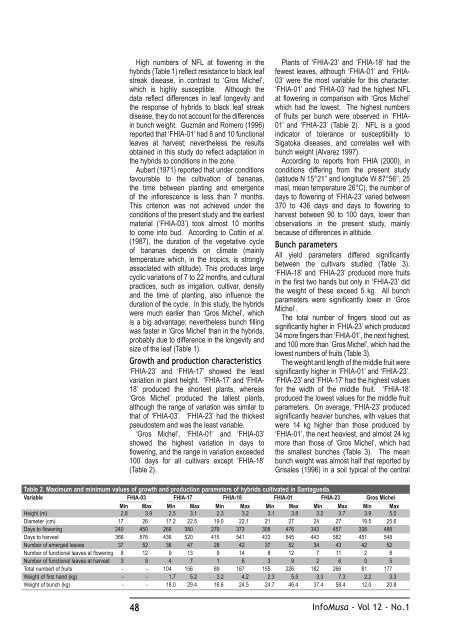Château-Musa - Bioversity International
Château-Musa - Bioversity International
Château-Musa - Bioversity International
Create successful ePaper yourself
Turn your PDF publications into a flip-book with our unique Google optimized e-Paper software.
High numbers of NFL at flowering in the<br />
hybrids (Table 1) reflect resistance to black leaf<br />
streak disease, in contrast to ‘Gros Michel’,<br />
which is highly susceptible. Although the<br />
data reflect differences in leaf longevity and<br />
the response of hybrids to black leaf streak<br />
disease, they do not account for the differences<br />
in bunch weight. Guzmán and Romero (1996)<br />
reported that ‘FHIA-01’ had 8 and 10 functional<br />
leaves at harvest; nevertheless the results<br />
obtained in this study do reflect adaptation in<br />
the hybrids to conditions in the zone.<br />
Aubert (1971) reported that under conditions<br />
favourable to the cultivation of bananas,<br />
the time between planting and emergence<br />
of the inflorescence is less than 7 months.<br />
This criterion was not achieved under the<br />
conditions of the present study and the earliest<br />
material (‘FHIA-03’) took almost 10 months<br />
to come into bud. According to Cottin et al.<br />
(1987), the duration of the vegetative cycle<br />
of bananas depends on climate (mainly<br />
temperature which, in the tropics, is strongly<br />
associated with altitude). This produces large<br />
cyclic variations of 7 to 22 months, and cultural<br />
practices, such as irrigation, cultivar, density<br />
and the time of planting, also influence the<br />
duration of the cycle. In this study, the hybrids<br />
were much earlier than ‘Gros Michel’, which<br />
is a big advantage; nevertheless bunch filling<br />
was faster in ‘Gros Michel’ than in the hybrids,<br />
probably due to difference in the longevity and<br />
size of the leaf (Table 1).<br />
Growth and production characteristics<br />
‘FHIA-23’ and ‘FHIA-17’ showed the least<br />
variation in plant height. ‘FHIA-17’ and ‘FHIA-<br />
18’ produced the shortest plants, whereas<br />
‘Gros Michel’ produced the tallest plants,<br />
although the range of variation was similar to<br />
that of ‘FHIA-03’. ‘FHIA-23’ had the thickest<br />
pseudostem and was the least variable.<br />
‘Gros Michel’, ‘FHIA-01’ and ‘FHIA-03’<br />
showed the highest variation in days to<br />
flowering, and the range in variation exceeded<br />
100 days for all cultivars except ‘FHIA-18’<br />
(Table 2).<br />
Table 2. Maximum and minimum values of growth and production parameters of hybrids cultivated in Santagueda.<br />
Variable FHIA-03 FHIA-17 FHIA-18 FHIA-01 FHIA-23 Gros Michel<br />
Min Max Min Max Min Max Min Max Min Max Min Max<br />
Height (m) 2.8 3.9 2.5 3.1 2.3 3.2 3.1 3.8 3.2 3.7 3.9 5.0<br />
Diameter (cm) 17 26 17.2 22.5 19.0 22.1 21 27 24 27 19.5 25.6<br />
Days to flowering 240 450 268 380 279 373 308 476 343 457 338 488<br />
Days to harvest 366 576 436 520 415 541 433 545 443 582 451 548<br />
Number of emerged leaves 37 52 36 47 28 42 37 52 34 43 42 52<br />
Number of functional leaves at flowering 8 12 9 13 9 14 8 12 7 11 2 8<br />
Number of functional leaves at harvest 3 9 4 7 1 6 3 9 2 6 0 5<br />
Total numbert of fruits - - 104 156 89 167 155 226 182 266 81 177<br />
Weight of first hand (kg) - - 1.7 5.2 3.2 4.2 2.3 5.5 3.3 7.3 2.2 3.3<br />
Weight of bunch (kg) - - 18.0 29.4 16.6 24.5 24.7 46.4 37.4 58.4 12.0 20.8<br />
48<br />
Plants of ‘FHIA-23’ and ‘FHIA-18’ had the<br />
fewest leaves, although ‘FHIA-01’ and ‘FHIA-<br />
03’ were the most variable for this character.<br />
‘FHIA-01’ and ‘FHIA-03’ had the highest NFL<br />
at flowering in comparison with ‘Gros Michel’<br />
which had the lowest. The highest numbers<br />
of fruits per bunch were observed in ‘FHIA-<br />
01’ and ‘FHIA-23’ (Table 2). NFL is a good<br />
indicator of tolerance or susceptibility to<br />
Sigatoka diseases, and correlates well with<br />
bunch weight (Alvarez 1997).<br />
According to reports from FHIA (2000), in<br />
conditions differing from the present study<br />
(latitude N 15°21’’ and longitude W 87°56’’, 25<br />
masl, mean temperature 26°C), the number of<br />
days to flowering of ‘FHIA-23’ varied between<br />
370 to 436 days and days to flowering to<br />
harvest between 90 to 100 days, lower than<br />
observations in the present study, mainly<br />
because of differences in altitude.<br />
Bunch parameters<br />
All yield parameters differed significantly<br />
between the cultivars studied (Table 3).<br />
‘FHIA-18’ and ‘FHIA-23’ produced more fruits<br />
in the first two hands but only in ‘FHIA-23’ did<br />
the weight of these exceed 5 kg. All bunch<br />
parameters were significantly lower in ‘Gros<br />
Michel’.<br />
The total number of fingers stood out as<br />
significantly higher in ‘FHIA-23’ which produced<br />
34 more fingers than ‘FHIA-01’, the next highest,<br />
and 100 more than ‘Gros Michel’, which had the<br />
lowest numbers of fruits (Table 3).<br />
The weight and length of the middle fruit were<br />
significantly higher in ‘FHIA-01’ and ‘FHIA-23’.<br />
‘FHIA-23’ and ‘FHIA-17’ had the highest values<br />
for the width of the middle fruit. ‘FHIA-18’<br />
produced the lowest values for the middle fruit<br />
parameters. On average, ‘FHIA-23’ produced<br />
significantly heavier bunches, with values that<br />
were 14 kg higher than those produced by<br />
‘FHIA-01’, the next heaviest, and almost 24 kg<br />
more than those of ‘Gros Michel’, which had<br />
the smallest bunches (Table 3). The mean<br />
bunch weight was almost half that reported by<br />
Grisales (1996) in a soil typical of the central<br />
Info<strong>Musa</strong> - Vol 12 - No.1

















